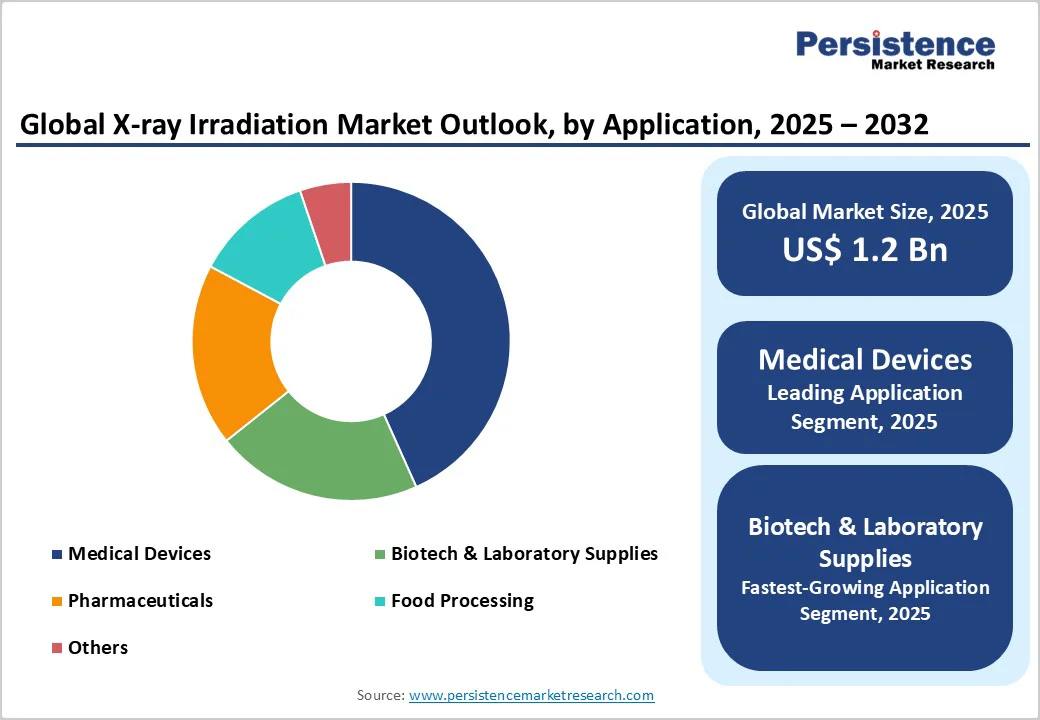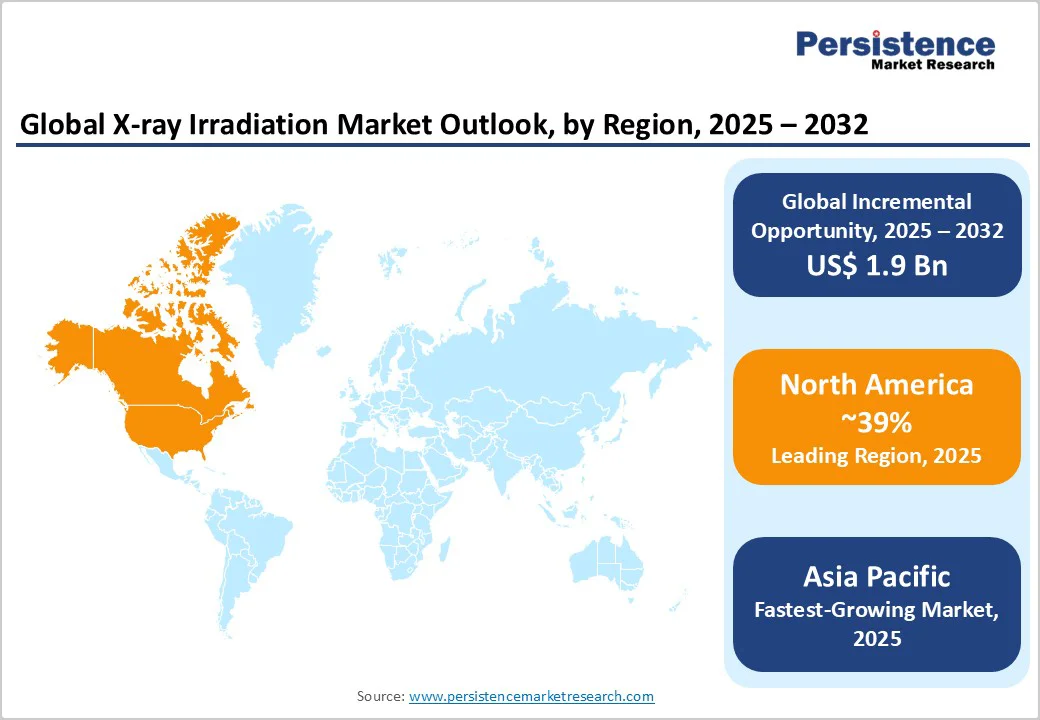ID: PMRREP35804| 186 Pages | 31 Oct 2025 | Format: PDF, Excel, PPT* | Healthcare

The global x-ray irradiation market size is likely to be valued at US$1.2 Billion in 2025, and is estimated to reach US$3.1 Billion by 2032, growing at a CAGR of 14.5% during the forecast period 2025 - 2032, driven by the widening adoption of X-ray technology in medical device sterilization, expanding biotech research use, and regulatory mandates favoring non-radioactive sterilization alternatives.
Market growth is driven by advancements in irradiation technology, rising healthcare investments, and regulatory initiatives like the U.S. Cesium Irradiator Replacement Project (CIRP), which promote safer X-ray sterilization over isotope-based systems, boosting global adoption.
| Key Insights | Details |
|---|---|
| X-ray Irradiation Market Size (2025E) | US$1.2 Bn |
| Market Value Forecast (2032F) | US$3.1 Bn |
| Projected Growth (CAGR 2025 to 2032) | 14.5% |
| Historical Market Growth (CAGR 2019 to 2024) | 8% |

The regulatory transition from radioactive isotope-based sterilization systems to X-ray irradiation technologies is a niche yet highly impactful driver shaping market dynamics. The U.S. Department of Energy’s CIRP, initiated to mitigate security risks associated with radioactive materials, mandates institutional replacement of cesium-137 and cobalt-60-based systems with alternative technologies, including X-ray irradiation. The global ripple effect of these policies extends to European Union (EU) member states and Asia Pacific countries, aligning with International Atomic Energy Agency (IAEA) guidelines, thereby creating a regulatory impetus boosting the demand for X-ray irradiation systems. This regulatory push mitigates security risks and supports safer sterilization, compelling medical device manufacturers, blood banks, and pharmaceuticals to prioritize X-ray adoption, directly stoking market growth.
Despite promising growth, the market encounters structural challenges stemming from the high upfront capital expenditure required for X-ray irradiation equipment acquisition and related infrastructure adaptation. Equipment costs often range upwards of US$500,000 per system, with installation necessitating extensive shielding and compliance with radiation safety standards, imposing budgetary constraints, especially on smaller healthcare facilities and emerging market participants.
Operational complexity demands skilled personnel, complicating adoption curves in regions with limited technical expertise. Regulatory compliance, though driving demand, simultaneously necessitates costly validation, certifications, and periodic audits, which cumulatively increase the total cost of ownership. Market risk analyses indicate that a notable percentage of potential buyers delay purchases, citing capital barriers, highlighting the significance of this restraint in market penetration rates, especially in low and middle-income countries.
Digital twin technology, virtual replicas of physical irradiation systems, enables continuous real-time monitoring, predictive analytics, and optimization of system performance based on operational data. By coupling X-ray irradiation equipment with IoT sensors and AI-driven analytics, operators can anticipate equipment failures, optimize irradiation dose delivery, and reduce downtime, thereby significantly enhancing operational efficiency and cost-effectiveness. This convergence addresses the unmet customer need for increased system reliability and throughput, especially in high-volume hospital sterilization facilities and biotech research centers, where equipment uptime critically impacts productivity. These factors, combined with growing investments into Industry 4.0 technologies in healthcare, position integrated X-ray irradiation and digital twin services as a major growth frontier offering differentiated value propositions.
Stationary X-ray systems currently dominate the technological front, with an estimated market share of 65% in 2025, favored for their reliability and high throughput in industrial and hospital applications. Their fixed installation design supports batch processing and automated sample handling, essential for large-scale sterilization projects. Portable/mobile systems are emerging rapidly, expected to grow at an estimated CAGR of 15.2% during 2025 - 2032, due to their increasing demand in emergency medical response and multi-facility deployment scenarios. Mobile X-ray systems offer flexibility and point-of-care applications, reducing logistical constraints, especially in developing regions. Benchtop and image-guided systems also contribute to market diversification, presenting compact solutions for laboratory environments with precision and safety enhancement features.
Within applications, medical devices are expected to retain their leading position in the market with an estimated 2025 market share of approximately 43.3%. This dominance is primarily driven by stringent regulatory mandates across key markets such as the U.S. and the EU, which emphasize sterilization protocols for surgical instruments, implantable devices such as stents and heart valves, and blood products. The replacement of traditional radioactive isotope sterilization methods (cesium-137, cobalt-60) with safer X-ray irradiation technologies is being accelerated by programs such as the CIRP, significantly expanding X-ray system adoption in hospitals, blood banks, and medical device manufacturing sectors.
The biotech & laboratory supplies segment is identified as the fastest-growing application, expected to grow at a CAGR of around 12.4% through 2032. This growth is largely fueled by expanding cell and tissue culture research initiatives, preclinical oncology studies, and emerging applications in immunology and genetic research, which require precise and minimally damaging sterilization or irradiation processes. The demand for compact, benchtop X-ray irradiators for laboratories and biotech startups is rising sharply due to their suitability for sterilizing sensitive biological materials while preserving integrity.
Large-scale systems are estimated to command approximately 58% of the revenue share in 2025, reflecting the immense demand from high-volume users such as major hospital blood banks, pharmaceutical manufacturers, and industrial sterilization facilities. These systems offer high throughput capacity, advanced automation, and batch processing features that justify premium investments by institutional buyers requiring reliability, scalability, and compliance with extensive regulatory standards. Their adoption is concentrated in developed markets with sophisticated healthcare and manufacturing infrastructure.
In contrast, small-scale or benchtop systems are emerging as the fastest-growing segment, anticipated to realize a CAGR of nearly 15% between 2025 and 2032. This surge is propelled by the proliferation of research laboratories, early-stage biotech firms, and clinical research organizations that prioritize cost-effective, flexible sterilization solutions that can be integrated easily into the existing laboratory workflows without the need for expansive infrastructure. Mid-scale systems occupy a strategic position, catering to regional transfusion centers and mid-sized laboratories, offering moderate throughput and greater operational flexibility.

North America is poised to dominate with an estimated 39.1% of the X-ray irradiation market share. Underpinned predominantly by the U.S., the regional market benefits from a rigorously enforced regulatory framework and a mature healthcare innovation ecosystem. The U.S. regulatory landscape, spearheaded by FDA guidelines and the Department of Energy's CIRP initiative, is proactively driving institutional replacement of cesium isotope systems with X-ray technologies.
Innovation ecosystems in high-income states such as California and Massachusetts are fostering partnerships between technology developers and healthcare providers, accelerating product commercialization and adoption. Market players operating in North America have prioritized product safety, automation, and integration capabilities, resulting in a competitive landscape with a mix of multinational corporations and specialized tech innovators. Investment trends indicate sustained capital flow into imaging innovation and contract sterilization service expansion, reinforcing the region’s market leadership.
Europe is likely to hold around 27% market share in 2025, with Germany, the U.K., France, and Spain being key contributors. The regional market is making exceptional gains from cohesive regulatory harmonization under the EU Medical Device Regulation (MDR) framework, streamlining product approvals and safety compliance. The Europe X-ray irradiation market is further propelled by healthcare modernization projects and rising adoption within academic research institutions engaged in oncology and radiobiology. Germany’s advanced manufacturing capabilities and the UK’s robust research funding provide growth momentum.
The market here is highly competitive, featuring long-established industrial players focusing on system reliability and cost efficiency, while emerging innovators leverage AI in dosimetry and imaging-guided sterilization. Investment activities emphasize the enhancement of existing sterilization infrastructure and the development of green sterilization technologies, aligning with EU sustainability targets.
Asia Pacific is the fastest-growing regional market, projected to exhibit a CAGR of around 14%% through 2032. The regional market benefits from escalating healthcare infrastructure investments, expanding biotechnology research sectors, and improving regulatory frameworks aligned to international safety standards. China leads market growth with capacity expansions in medical device manufacturing and government incentives promoting non-radioactive sterilization technologies. India and ASEAN countries represent emerging markets with significant unmet demand, propelled by increasing hospital infrastructure and growing blood transfusion services. Manufacturing advantages, including lower production costs and skilled workforce availability, enable local equipment production and service provision. This regional surge attracts global suppliers and regional partnerships, accompanied by growing investment in technical education and infrastructure upgrades.

The global X-ray irradiation market structure is moderately consolidated, dominated by a handful of companies. Key market leaders have been focusing on comprehensive product portfolios that span stationary, portable, and benchtop systems. Market concentration is increasing due to ongoing acquisitions and strategic partnerships, enhancing technological capabilities and geographical reach. The competitive environment is characterized by a blend of established multinational corporations with advanced innovation pipelines and specialized regional suppliers focusing on customized solutions. Increasing demand for automation, AI integration, and safety compliance is reshaping competitive positioning, with new entrants emphasizing niche segments such as biotech research instrumentation and contract sterilization services to differentiate.
The X-ray irradiation market is projected to reach US$1.2 Billion in 2025.
The widening adoption of X-ray technology in medical device sterilization, expanding biotech research use, and regulatory mandates favoring non-radioactive sterilization alternatives are driving the market.
The X-ray irradiation market is poised to witness a CAGR of 14.5% from 2025 to 2032.
Advancements in irradiation technologies, increasing healthcare infrastructure investments, and favorable regulatory frameworks catalyzing the replacement of isotope-based sterilization systems with safer X-ray alternatives are key market opportunities.
Xterra Medical Technologies, Steril Systems Inc., and Radion Technologies are some of the key players in the X-ray irradiation market.
| Report Attribute | Details |
|---|---|
|
Historical Data/Actuals |
2019 - 2024 |
|
Forecast Period |
2025 - 2032 |
|
Market Analysis |
Value: US$ Bn |
|
Geographical Coverage |
|
|
Segmental Coverage |
|
|
Competitive Analysis |
|
|
Report Highlights |
|
By Technology Type
By Application
By Scale
By Region
Delivery Timelines
For more information on this report and its delivery timelines please get in touch with our sales team.
About Author